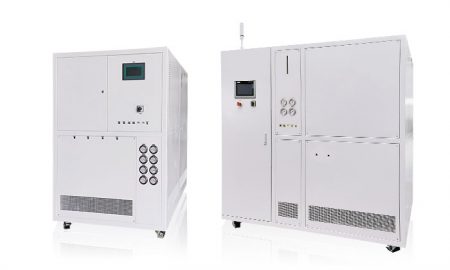Liquid Cooling of ESS Container
Contact us today for the perfect temperature control solution
Currently, temperature control technologies in the energy storage field mainly include air cooling and liquid cooling. Air cooling technology is extended from air conditioners, while liquid cooling technology is borrowed from electric vehicles. Air-cooling heat dissipation uses a fan to bring the heat generated by the battery core to the outside, and liquid cooling heat dissipation uses coolant convection heat transfer to accurately manage the temperature of each battery core. Air-cooling technology was first commonly used in energy storage systems because the technology has a simple structure, mature technology, and low cost, and can achieve rapid delivery and deployment. However, the air-cooling system is large in size and is greatly affected by the external environment. It has problems in terms of system safety, efficiency, and economy. There are many problems in terms of performance, and the emergence of liquid-cooled energy storage just solves the above problems.
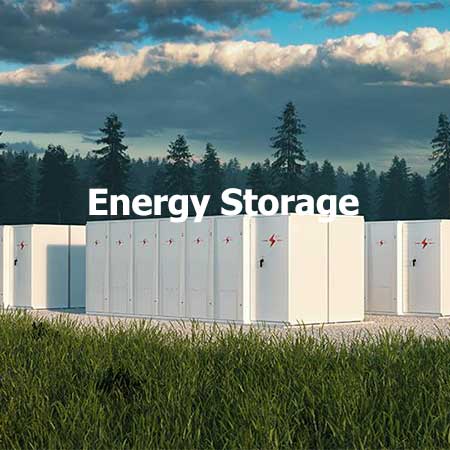
1. Principle of energy storage system (ESS) container liquid cooling system
Liquid cooling systems are currently a popular research direction in power battery thermal management. They utilize the coolant’s large heat capacity and ability to take away excess heat from the battery system through circulation to achieve optimal operating temperature conditions for the battery pack. The basic components of the liquid cooling system include: liquid cooling plate, liquid cooling unit (heater optional), liquid cooling pipeline (including temperature sensor, valve), high and low voltage wiring harness; coolant (ethylene glycol aqueous solution), etc.
The cooling circuit of battery packs generally uses a parallel circuit to reduce the temperature difference between battery packs; battery packs generally use large battery boxes (30-50KWh/Pack) to improve system integration and reduce costs; the liquid cooling unit is arranged Both distributed and centralized. The distributed type uses one cluster or two clusters to configure one liquid cooling unit, which is generally used for a single outdoor cabinet; the centralized type uses a container system to configure one or two liquid cooling units.
2. Main advantages of energy storage liquid cooling system
(1) Safer. As the scale of energy storage project construction continues to increase, the battery cell capacity and system energy density are also increasing. Even if large-capacity batteries are used, it still takes more than a dozen to build a 100-megawatt energy storage project. Thousands or even hundreds of thousands of battery cells are combined together, which will generate greater heat and place higher requirements on the temperature control management of the energy storage system. Liquid-cooled energy storage has high technical content. It directly dissipates heat to the battery core through coolant convection. The method is controllable and is not affected by external conditions. It also has high heat dissipation efficiency and more precise temperature control. Due to factors such as small air specific heat capacity and convection heat transfer coefficient, battery air-cooling technology has low heat transfer efficiency, and the battery heat generation increases, which will cause the battery temperature to be too high, and there is a risk of thermal runaway; the liquid cooling solution can rely on a large flow of cooling medium To force the battery pack to dissipate heat and realize heat redistribution between battery modules, it can quickly inhibit the continued deterioration of thermal runaway and reduce the risk of runaway.
(2) More economical. In addition to safety, the integrated design of energy storage systems also takes into account the operation and maintenance of the entire life cycle. Liquid-cooled energy storage systems are more economical. The energy storage system generates a lot of heat during operation and dissipates heat unevenly, which not only endangers the safety of the battery energy storage system, but also affects the battery life. Through cluster-level controllers and intelligent temperature control and balancing control technology, the energy storage liquid cooling system can make the temperature of the battery core more uniform through the settings of pipelines and liquid flow. To achieve the same average battery temperature, air cooling requires 2-3 times higher energy consumption than liquid cooling. The maximum temperature of the battery pack under the same power consumption is 3-5°C higher with air cooling than with liquid cooling, and liquid cooling has lower power consumption.
(3) More suitable for long-term energy storage. From 2021 to now, various policies related to energy storage ratios have been introduced across the country, which involve two indicators, one is the power ratio, and the other is the energy storage duration. The power proportion ranges from 5% to 30%, and the energy storage time ranges from 1h to 4h. If the 4h battery energy storage system continues to use air-cooled heat dissipation technology, although its structure is simple and the cost is low, the heat generated by the battery core is directly brought to the outside through the fan, but it has low heat transfer coefficient, slow cooling speed, and requires a large area. The heat dissipation channel and other disadvantages, its area will be very huge. Liquid cooling technology has the advantages of high thermal conductivity, more uniform heat dissipation, lower energy consumption, and less floor space. The liquid-cooled energy storage system container solution has high heat dissipation efficiency. Compared with traditional air-cooled containers, the power density is increased by 100%. , saving more than 40% of the floor space, and is more suitable for large-scale and long-term energy storage scenario applications.
Email: info@lneya.com WeChat ID: +8615251628237 WhatsApp: +86 17851209193
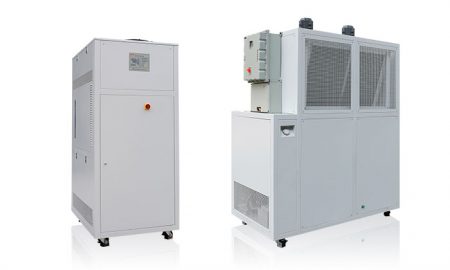 Precision Chillers / Small Chillers
Precision Chillers / Small Chillers
The chiller can be widely used in various industries and laboratories, and supports customized design.
| Temperature range | -18°C ~ +30°C | +5°C ~ +35°C series |
| Cooling Capacity | 0.35 ~ 0.9kW | 1.8 ~ 50kW |
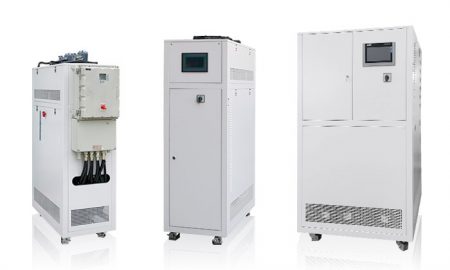
Recirculating Chillers
Our recirculating chiller adopts low-temperature refrigeration technology, the temperature is as low as -120℃, and various accessories are customizable.
| Temperature range | -25°C ~ +30°C series | -45°C ~ +30°C series | -60°C ~ -20°C series | -80°C ~ -20°C series | -120°C ~ -70°C series |
| Cooling Capacity | 0.8 ~ 30kW | 0.75 ~ 12kW | 0.4 ~ 6kW | 0.2 ~ 6kW | 0.3 ~ 5kW |
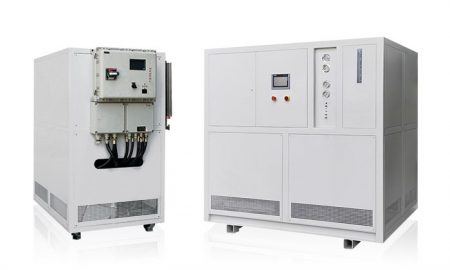
Low Temperature Chillers
We specialize in the production of low-temperature chillers with a temperature control range as low as -150°C, which can meet the refrigeration needs of different industries.
| Temperature range | -25°C ~ -5°C series | -45°C ~ -10°C series | -60°C ~ -10°C series | -80°C ~ -30°C series | -110°C ~ -50°C series | -150°C ~ -110°C series |
| Cooling Capacity | 12 ~ 360kW | 6 ~ 180kW | 6 ~ 180kW | 4 ~ 180kW | 2 ~ 120kW | 2.5 ~ 11kW |
Temperature simulation for vehicle quality test: battery life test, fuel injector/motor test bench, airbag test, component test bench, etc.
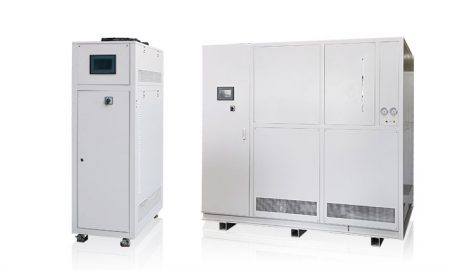
Suitable for precise temperature control of electronic components. In the manufacture of semiconductor electronic components for harsh environments, the IC packaging assembly and engineering and production testing phases include electronic thermal testing and other environmental testing simulations.

Liquid Cooling For Battery Energy Storage Systems
| Types | For Converting Station | For Energy Storage Battery | For Charging Station |
| Cooling Capacity | 45kW | 5 ~ 8.5kW | 4kW |

ZLFQ Series
Coolant Distribution Unit
Liquid cooling equipment is suitable for semiconductor testing, electronic equipment constant temperature testing, cooling server supporting infrastructure, and other fluid temperature control places.
| Temperature range | +5°C ~ +35°C | +5°C ~ +35°C |
| Cooling Capacity | 15 ~ 150kW | 200 ~ 500kW |

MD Thermal Chucks Series
It is used for testing RF devices and high-density power devices (IGBTs and MOSFETs), and can also be used for rapid cooling of laboratory flat panels (plasma, biological products, batteries), etc.
| Temperature range | -75°C ~ +225°C |
| Temperature accuracy | ±0.1℃ |
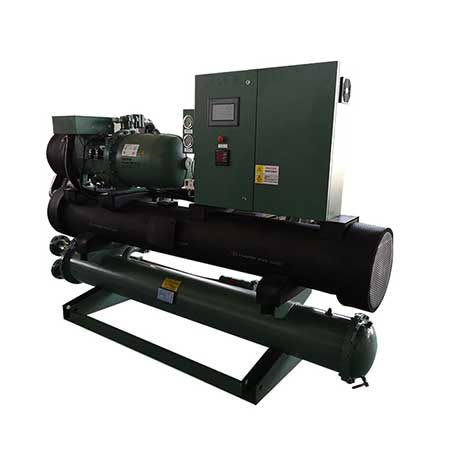
Screw Chillers (Custom Designs)
Low temperature screw chillers and room temperature screw chillers
| Temperature range | +5°C ~ +30°C | +5°C ~ +30°C | +5°C ~ +30°C | +5°C ~ +30°C | -25°C ~ +5°C | -25°C ~ +5°C |
| Cooling Capacity | 107 ~ 1027kW (Single Compressor) | 299 ~ 2134kW (Dual Compressor) | 98 ~ 934kW (Single Compressor) | 272 ~ 1940kW (Dual Compressor) | 48 ~ 467kW (Single Compressor) | 51 ~ 497kW (Single Compressor) |
 LNEYA
LNEYA
 简体中文
简体中文












































































